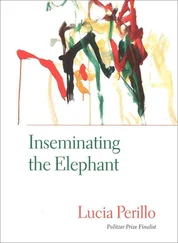A few relatively flat meadows exist in Paradise — hence its popularity with nineteenth-century campers. From here a series of hillocks stair-step up — to a large snowfield that ends in Camp Muir, at 10,000 feet, where a climber has to rope up to begin glacier travel. On this day I can’t see the mountain’s top, and the high clouds shrink the distances. The Tatoosh Range is visible to the south — black crags down which I glissaded every summer, an unmarked route that dropped back to Longmire.
Today we set off to wherever the dinky concrete trail leads. You can tell that the ground is not used to being exposed, as it is on this dry year with scant snow cover — the soil is brown and dusty between the various clumps of alpine leafage. Angus keeps forgetting that it’s against the rules to wander off the trail — whenever we see a flower his impulse is to march straight for it. I would prefer that no one talk, a remnant from those days when I traveled alone, but how do you say to your friends, Please do not speak ? It is rarely possible nowadays for me to replicate the experience of traveling alone. Sometimes Jim and I can manage it, but I am tired of requiring a husband.
People coming down the trail nod to encourage me a little more enthusiastically than seems natural, but I will not let this piss me off today. The ones who keep to themselves are those who have come down from the mountain’s upper reaches. When I worked here I climbed to the top each year, just to prove that I could, and so I know them not just by their plastic climbing boots but also from their leathered skin that tells me they have spent time above the clouds. You climb at night, when there is less danger that ice will melt and crevasses pop open, and you try to time it so that you get to the summit not long after the break of day. That first light is an oozy purple with the clouds below, when you gradually step out of their last stratum. That light is what people climb for, I think. Everything else is dark or heat or cold or exhaustion, but the early light is heaven.
Now there is one young woman walking down alone with ski poles in her hands to break the impact on her knees. Her hair has been pinned up carelessly, and her gaiters and clothes are ragged. I want to stop her and suck her blood: I was you, make me you again. I should know better — if she really is me, then she would probably resent the intrusion on her privacy.
Since I can’t march, my plan is to be content with identifying the plants, even though it seems unnatural to wrench knowledge from the field guides without balancing that knowledge with some gained by experience. So I tell myself: Okay, have an experience. Two ravens swing on branches overhead along with the other birds made bold by years of snack food. This is my experience: to hear the ravens croak. To hear the slow, sporadic way they say the word grok. (This, the book says, is how you tell them from crows.)
It turns out that we are indeed late for the peak blooming weeks, which come right after snowmelt. And it is my habit to sulk when I feel that my perfect experience has been foiled by my disease — if I were healthy, I would have come here alone and sooner. But Becky points out that there are still plenty of ragged stragglers, like the blue cascade asters everywhere. And purple gentian, the last bloomers, just coming up, their flowerheads like little boxing gloves punching upward from the ground.
Dirty white mops, which are the seed heads of spent anemone flowers, stake the hillside. And the tall dry stalks of hellebore, a plant distinguished by its pleated leaf. Becky and I stop often to consult the field guides and play our knowledge game. Angus is fidgety and wanders ahead until he realizes he’s lost his $500 Harley-Davidson sunglasses and heads back down in a tizzy to see if he’s left them on the bike. We wait for him at a dip with a trickle of snowmelt where neon-pink monkeyflowers still bloom.
Even before he returns over the rise, we can hear him coming back up: now he’s wearing the sunglasses and talking on his cell phone. When he gets off the line, I grouch at him for trammeling on my nature experience with his technology and loud blabbering.
“But I wanted to call my brother George! I wanted to tell him about all this!” His excitement shows in his voice’s high pitch, as if we have taken him to the moon. He tried to come here once with his wife, he says, but heights scared her and they turned back.
And now my friends force me to turn back because the asphalt is getting rugged and ripped. I have no choice but to let them have their way since they are the ones who’ve been pushing me free when my wheels spin, though not to end somewhere spectacular seems anticlimactic, and I feel my expectations plummeting again, which forces me to find an Indian paintbrush flower still in bloom so I can write this down in my book of gratitudes.
The scooter skids down the pavement — the paths have been steeper than I realized. Angus and Becky walk in front of me and promise they’re willing to throw themselves in my path if I lose control. I’ve given up on having a meditative experience, though there are not many people out on this gray day. Still, when we come to a marmot near the trailside, I tell my friends to shut up for a while.
The marmot makes a show of chewing its dry weeds, its silver fur rippling on its perch on a rock. Long ago, I chose this species for my totem animal: for its sweet whistle but mostly for its sluggishness and love of sleep. It does not keep score of its accomplishments. And it doesn’t need to keep a book of gratitudes because it’s grateful for every leaf it bumbles on.
We stand frozen, and the marmot doesn’t flinch, not even when a family comes noisily trooping down the trail.
“Hey!” they yell to us, and still the marmot doesn’t spook. “He was in that same spot hours ago when we passed him going up.”
Marianne Moore also includes the marmot in her poem, supposedly as a surrogate for her brother, after learning that her first choice, the badger (from Wind in the Willows ) was not found on this mountain. The marmot’s whistle she describes as “the best wild music of the forest,” the marmot itself the victim of “a struggle between curiosity and caution.”
But our real marmot does not seem to be struggling with caution, and the only way we’d arouse its curiosity is if we held out a potato chip, which is against the rules. Moore quotes with condescension from the park rules of her day: “that one must do as one is told” and conform with the man-made regulations if one is planning to conquer the wilderness, the place where you’d think you’d be most free. Nowadays the most pointed example I can think of is that once you step onto the glacier to begin your travel there, you must carry down any waste you generate in a blue plastic bag. There are two methods, I was told: you either use the bag like a mitten or squat over it, making a direct deposit.
Two-thirds of the way through Moore’s poem about Mount Rainier, she suddenly brings up the ancient Greeks and their fondness for smooth and polished surfaces, their shunning of the disorder that more truly characterizes nature. Happiness is attained by willpower, she says, with Greek civilization
ascribing what we clumsily call happiness
to “an accident or a quality
a spiritual substance or the soul itself,
an act, a disposition, or a habit
or a habit infused, to which the soul has been persuaded,
or something distinct from a habit, a power”
Happiness comes through persuasion and practice, according to Moore: it’s an unnatural state of being that we can learn. As far as my own happiness goes, the first thing I have to learn in order to attain it is how not to envy healthy, hearty people like Marianne Moore — who poses in old photos with her gaiters and alpenstock.
Читать дальше











![Various - Birds and Nature, Vol. 12 No. 5 [December 1902]](/books/745517/various-birds-and-nature-vol-12-no-5-december-thumb.webp)
![Various - Birds and Nature Vol. 11 No. 2 [February 1902]](/books/745533/various-birds-and-nature-vol-11-no-2-february-1-thumb.webp)